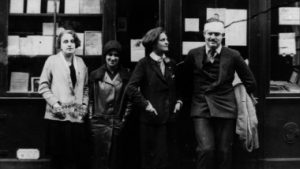Sylvia Beach was a facilitator of the success of the Lost Generation in 1920s Paris. The bookshop owner and publisher is famous for founding the iconic Shakespeare & Company on the Rue Dupuytren.
Her establishment served as a gathering place and publishing house for many of the expatriate writers in Paris at the time, including James Joyce, F. Scott Fitzgerald, and Ernest Hemingway. She specialized in American and English literature, helping to expose writers to a French market. She published their original works, including Joyce’s Ulysses, after being rejected by publishers in the United States and England.
Hemingway was quick to track down the literary hub, becoming a frequent visitor after only a week of being in Paris. Until the shop’s unfortunate closing in 1941 due to Nazi occupation, Hemingway remained in contact with Beach, exchanging letters and even stopping in sometimes to sign his books. In his memoir A Moveable Feast, Hemingway leaves no doubt that Beach and her progressive oasis were key to his success as an up-and-coming writer.[6]
When a young Hemingway was wounded by shrapnel while driving an ambulance during the First World War, he fell in love with his hospital nurse, the beautiful Von Kurowsky. This affair between nurse and patient, as brief as it was, inspired Hemingway in the many years to come, namely by influencing his novel A Farewell to Arms.
The character of Catherine Barkley is based on Von Kurowsky, and the hero, Frederic Henry, is a wounded American soldier, much like Hemingway in his own life. In the story, Catherine nurses Henry, and they eventually fall in love—again, much like Hemingway’s experience–but the tale does not have a happy ending, as Catherine dies in childbirth.
While Agnes and Ernest may not have had such a tragic end, his heart was broken nonetheless. He wrote, “I’ve loved Ag. She’s been my ideal… I forgot all about religion and everything else because I had Ag to worship.”[7]
The Lost Generation and Ernest Hemingway’s Inspiration for ‘The Sun Also Rises’ | PBS
One such example was his novel The Sun Also Rises, Hemingway’s debut novel. It was based upon a trip he and a group of his fellow expatriates took to Pamplona, Spain. Hemingway went with his wife Hadley, a few gentlemen friends, and Lady Duff Twysden. Lady Twysden was going through a messy divorce and having affairs with a couple of said gentlemen’s friends in the traveling party.
What ensued among the bullfights and brunches was a flurry of insults, fights, sexual tension, sordid affairs, and too much alcohol. Hemingway, in the middle of it all and struggling with his first attempt at a novel, absorbed every moment and, in just six weeks, produced a first draft of The Sun Also Rises.
Many members of the party, including Lady Twysden, were not happy with Hemingway’s publication, claiming that it was hardly fiction at all but rather a pages-long gossip column. Lady Twysden and the posse even coined the terms “B.S.” and “A.S.” to stand for “Before Sun” and “After Sun” because of how much their lives changed after Hemingway’s stunt.
As much as they may not have liked the novel, the fact of the matter is that their lives as the Lost Generation were the perfect fodder to launch a timeless and remarkable literary career.[8]
Androgyny and the Dysfunctional Marriage of Ernest Hemingway and Mary Welsh | PBS
Mary Welsh was Hemingway’s fourth and final wife. While she may not have been a riveting muse, like many women in his life, her influence over his life and legacy is no less significant. Much of the Hemingway history we have today can be attributed to her diligence in preserving his legacy in the years following his death.
She and Ernest spent the last 15 years of his life together, traveling to Cuba, Africa, Spain, and beyond, before finally settling in Ketchum, Idaho. During that time, he won the Nobel and Pulitzer Prizes for literature and survived two plane crashes. Through his literary success and declining mental and physical health, Mary was by his side.
She was also present in their home when he committed suicide on July 2, 1961, at the age of 61. Following his death, Mary stewarded his legacy through the publication of his famous memoir, A Moveable Feast, and donated many of his photographs and letters to the John F. Kennedy Library.[9]
1Valerie Hemingway
At 19 years old, she landed a job interviewing the prolific author in Spain with the publication she was working for. The pair instantly hit it off, with Ernest taking a keen interest in the whip-smart young lady who could hold her liquor and take a joke.
Eventually, he hired her as his personal secretary, a position that would prove critical to the posthumous publication of works like A Moveable Feast. She remained a part of his entourage until his death and continued to be a mainstay in the Hemingway family. She collaborated with Hemingway’s widow, Mary Welsh, to piece together his memoir and even married Hemingway’s son Gregory, whom she divorced later.
Valerie has certainly done the Hemingway name honor through her own work as a writer, journalist, speak





